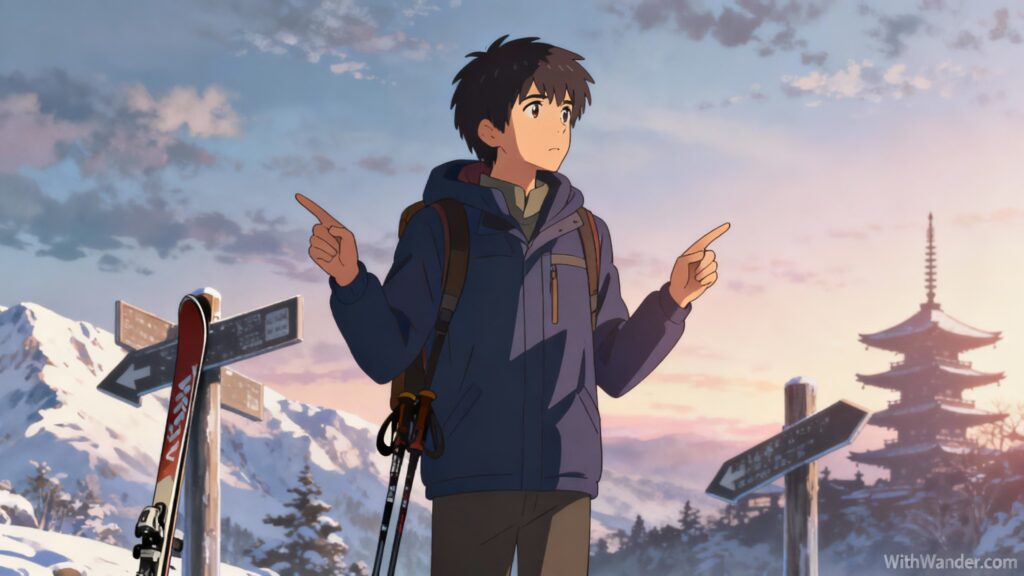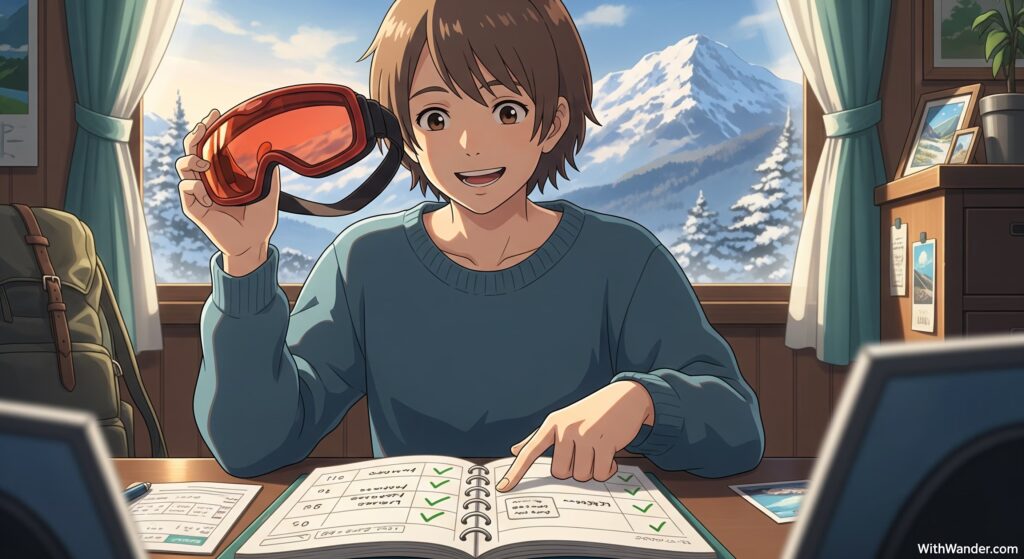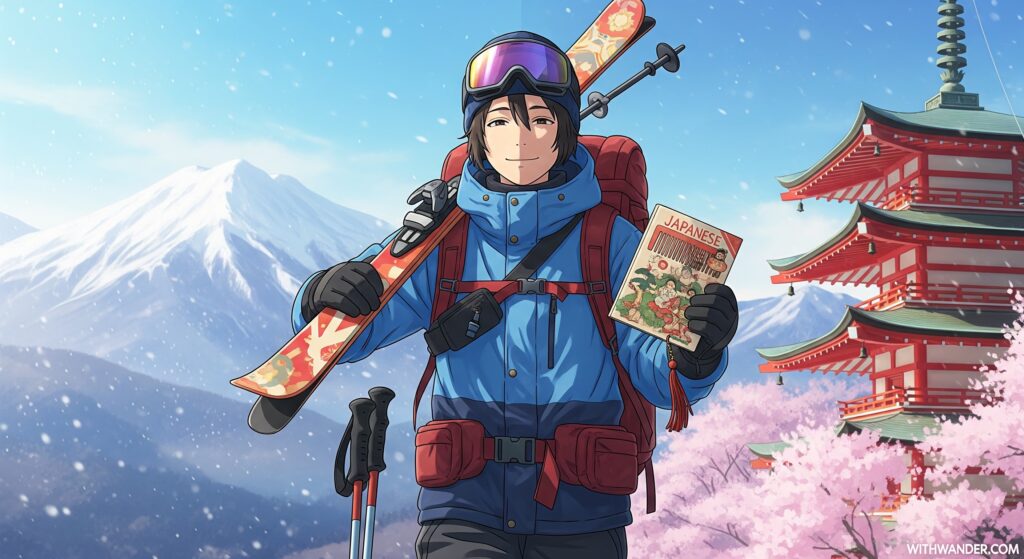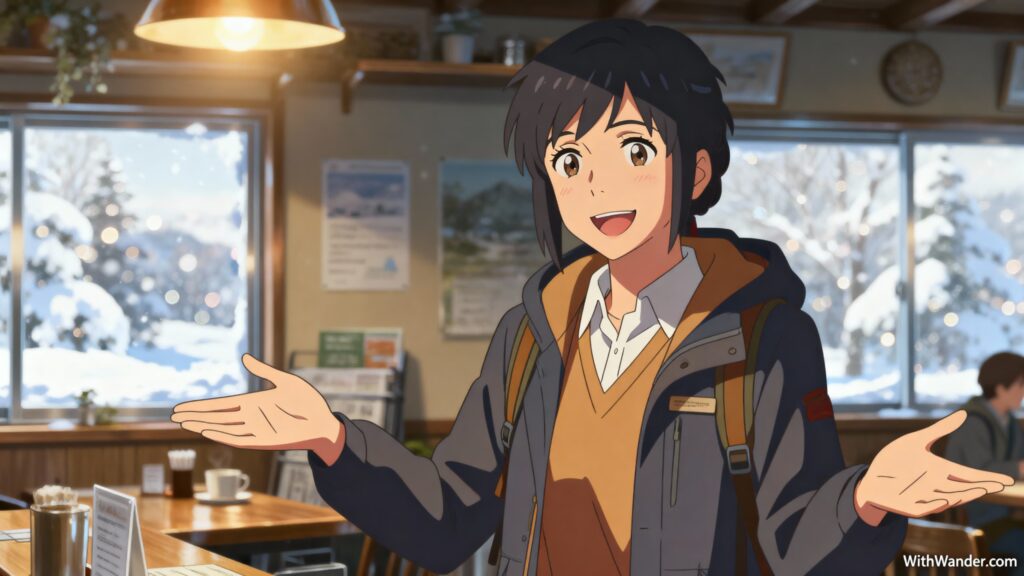INDEX
I stood at a crossroads at Kyoto Station, scrolling through train schedules.
One path led west to the profound history of Hiroshima.
The other shot north towards the legendary powder of the Japanese Alps.
As a solo traveler on a finite budget and timeline, this is a common Japan winter dilemma.
So, is Myokokogen worth the trip when weighed against iconic cultural sites?
The answer depends entirely on the kind of experience you’re after.
This guide is built from my own decision-making process.
We’ll compare the options directly, map out the logistics, and give you clear, tested answers so you can choose the right path for your adventure.
Is Myokokogen Worth the Trip for Solo Travelers?

Yes, Myoko Kogen is absolutely worth the trip for solo travelers, but with a condition: you must love snow.
If you’re a skier or snowboarder, from beginner to expert, the value is exceptional.
It offers a more authentic, less crowded, and often more affordable alternative to bigger names like Niseko or Hakuba.
What makes it stand out is the sheer volume and quality of its snowfall, combined with a rustic, laid-back village atmosphere.
It’s the perfect place to experience Japan’s famous “Japow” without the international resort polish.
🌍Musa’s Take: The Myoko Vibe
Myoko felt like a real discovery. It’s not just a resort; it’s a collection of villages with deep roots. I found myself in small izakayas sharing stories with locals and Australian ski bums alike. It’s this blend of authentic Japanese mountain culture and a welcoming international snow community that makes it special for a solo visitor.
The Great Debate: Hiroshima vs Skiing for Solo Traveler Japan

This is the core choice for many winter itineraries.
Do you seek historical reflection or the thrill of waist-deep powder?
Both are powerful experiences, but they serve very different travel needs.
I’ve broken down the decision into a direct comparison.
“Japow” is real, it’s incredibly light and dry snow.
A fantastic break from cities and temple sightseeing.
Ski towns are social, easy to meet people in lodges and bars.
The onsen (hot spring) culture after skiing is unbeatable.
Costs add up: lift pass, gear rental, transport.
It consumes at least three full days of your itinerary.
Weather dependent, a bad-weather day can be a write-off.
You miss out on historically significant parts of Japan.
Profoundly moving and important for understanding modern history.
Himeji Castle is Japan’s most spectacular, a true icon.
Very easy to access with a Japan Rail Pass on the Shinkansen.
Miyajima Island near Hiroshima is a beautiful side trip.
The Peace Memorial Museum is emotionally draining, be prepared.
It’s a more conventional tourist route, less of a raw adventure.
You are spending your time looking back, not living an active thrill.
The experience is more inwardly focused, perhaps less social.
How to Get to Myokokogen from Kyoto

Getting there seems complicated, but it’s a classic Japanese transit puzzle that is satisfying to solve.
Your main goal is to get to Joetsumyoko Station, the Shinkansen hub for the area.
From there, it’s a short local bus or shuttle ride to the ski villages.
Here are the most practical routes I researched and used.
My recommended route. Take the Thunderbird Limited Express train from Kyoto to Kanazawa or Tsuruga. The first train departs Kyoto at 06:59 and arrives in Kanazawa at 09:55. Transfer to the Hokuriku Shinkansen bound for Tokyo and get off at Joetsumyoko.
A much longer and more expensive option, but simple if you’re using a Japan Rail Pass and prefer staying on Shinkansen lines. Take the Tokaido Shinkansen to Tokyo Station, then transfer to the Hokuriku Shinkansen.
💡Japan Rail Pass Tip
Before buying a Japan Rail Pass for this journey, do the math. The price increases have made single tickets a better value for many routes. I used the official JR Pass Calculator and found that for my specific plan, buying individual tickets for the Thunderbird/Hokuriku route was cheaper.
Adding a Ski Trip to a Japan Itinerary: A 3-Day Plan

Squeezing in a ski trip requires efficiency.
Three days is the minimum I’d recommend to make the travel time worthwhile.
Here’s a blueprint for a quick and effective mountain escape.
The travel from Kyoto or Tokyo will take up your morning.
Arrive at your lodge, drop your bags, and head straight to a rental shop.
Getting skis, boots, and helmet sorted today saves precious time tomorrow.
A quick walk around the village and an early night is the plan.
This is your one full day, so be on the first lift.
Explore one of the main areas like Akakura Onsen or Suginohara.
Stop for a classic mountainside lunch, katsu curry is a must.
Finish the day completely tired, then soak in a local onsen.
Wake up early for a few more hours of skiing on fresh legs.
Aim to be done around noon to return your gear.
Grab your luggage and catch the shuttle back to Joetsumyoko station.
You’ll be on your way to your next destination by mid-afternoon.
Is Himeji Castle Worth Visiting in Winter?

A resounding yes.
I visited Himeji on a crisp January morning, and it was a highlight.
The biggest advantage of a winter visit is the reduced crowd size.
You can explore the castle’s intricate wooden interior without shuffling in a long line, which is common in spring and autumn.
While you might not see the famous cherry blossoms, the castle’s white walls stand out brilliantly against the bare trees and clear blue winter sky.
If you’re lucky, a light dusting of snow turns the entire scene into a perfect picture.
-
Himeji Castle Main Keep
The main event. (Entry: ¥1,000 until March 2026, then ¥2,500 for non-residents). Be ready for steep, narrow stairs. The view from the top floor is spectacular and gives you a sense of the castle’s strategic importance. Visit before March 2026 to save on admission fees.
-
Koko-en Garden
Next to the castle. (Combined Ticket: ¥1,050). Even in winter, the garden’s structure, ponds, and teahouses are beautiful and peaceful. A great way to wind down after the castle climb.
My Solo Traveler Verdict: Combining Both Worlds

After weighing all my options, I realized that with a bit of smart planning, I didn’t have to choose.
On a 12-day trip, I managed to do both.
The key was treating the ski segment as a focused, 3-day “mini-trip” within my larger itinerary.
My route was: Tokyo -> Myoko Kogen (3 days) -> Kyoto -> Himeji (day trip) -> Hiroshima.
This flow minimized backtracking and made the most of my transport.
To help you visualize the budget trade-off, here’s a rough breakdown for a 3-day solo excursion to each.
- Myoko Kogen Ski Trip (3 Days/2 Nights):Hostel, lift passes, gear, food. ~¥45,000. Active & social.
- Hiroshima & Himeji Trip (3 Days/2 Nights):Hostel, transport, entry fees, food. ~¥30,000. Historical & reflective.
Ultimately, Myoko Kogen was absolutely worth it.
It was the perfect physical and mental contrast to the temples of Kyoto and the solemnity of Hiroshima.
It added an element of pure, unadulterated fun to my trip that I wouldn’t trade.
FAQs: Your Questions on a Myokokogen Trip

What’s the snow like in Myoko Kogen?
The snow is the main reason to go. It is famous for receiving huge amounts of light, dry powder snow, often called “Japow.” This makes for incredible skiing and snowboarding conditions, especially if you enjoy off-piste or tree runs.
Do I need to speak Japanese in Myoko Kogen?
In the main tourist areas like Akakura Onsen village, you can get by easily with English. Most hotels, rental shops, and many restaurants have English-speaking staff due to the large number of international visitors. Learning a few basic Japanese phrases like “Arigato” (Thank you) is always appreciated.
Is Myoko Kogen good for beginners?
Yes. While it’s a paradise for experts, resorts like Akakura Onsen have fantastic, wide-open beginner slopes. There are numerous ski schools with English-speaking instructors available, making it a great place to learn.
Can I rent all my ski gear there?
Absolutely. There are dozens of rental shops in the main villages of Myoko. You can rent a complete package including skis/snowboard, boots, poles, jacket, pants, helmet, and goggles. I found the quality to be high and the prices reasonable.
Is skiing in Myoko Kogen more expensive than visiting Hiroshima?
Yes, a ski trip to Myoko Kogen is generally more expensive. Based on a 3-day solo trip, the estimated cost for Myoko is around ¥45,000, while a similar trip to Hiroshima and Himeji would be closer to ¥30,000, mainly due to lift passes and gear rental.
What is the best way to travel from Kyoto to Myoko Kogen?
The most recommended route is taking the Thunderbird Limited Express train from Kyoto to Kanazawa or Tsuruga, then transferring to the Hokuriku Shinkansen to Joetsumyoko Station. This trip takes approximately 3.5 to 4 hours.
Is it crowded at Himeji Castle during the winter?
No, a major benefit of visiting Himeji Castle in winter is the smaller crowd size. This allows you to explore the interior without the long lines that are common in peak seasons like spring and autumn.
How many days should I plan for a trip to Myoko Kogen?
You should plan for a minimum of three days. This allows for one full day of travel and gear preparation, one full day on the slopes, and a final morning for a few more runs before departing.
Is Myoko a good destination for a solo traveler to be social?
Yes, it’s a great choice. The article mentions that ski towns are social and it’s easy to meet people in lodges and bars. The vibe is a mix of authentic Japanese culture and a welcoming international snow community, making it easy to connect with locals and other travelers.
